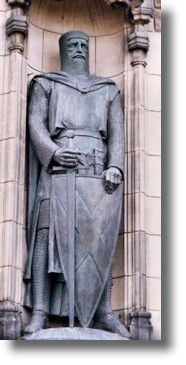
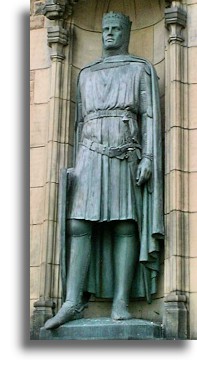
Scots History to 1400
By Michael Lynch
This is a section from the book "Scotland: a New History" by Michael Lynch which covers Scottish history from the earliest times to the present. There is an Index page of all the sections of the book up to the end of the 14th century which have been added to Rampant Scotland. The pages were previously part of the "Scottish Radiance" Web site.
Saint Columba
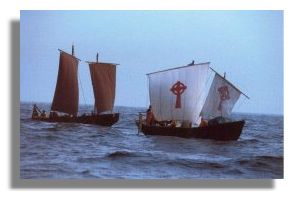 For both Ninian in the fifth century and Wilfrid and Bede in the seventh and eighth-century Northumbrian Church, the terrain of Scotland was the main arbiter of their thinking. They sought to claim as their own the natural breaks of valleys which mostly ran south and north to the barrier of the Forth and to find ways to hurdle that natural frontier. For Columba and his successors as abbots of Iona the geography of Scotland was quite different. Their natural routes of communication were by sea, across to Ireland and along the west coast of the Scottish mainland. The natural barrier for them was the Highland massif, which they called Druim Alban, 'the spine of Britain'. The dove of the church and his followers did not make their first push due east as the crow flies, across the massif before reaching the easier ground of the straths of the Tay and the Earn, but north-east through the huge fault of the Great Glen towards Inverness and south-east towards Lothian and Berwickshire. What is important to realise about that route is that when it was taken, by kings of Dalriada when they became kings of Picts in the ninth century, the Dalriadic church - of Iona - followed, but in a new guise. Columba's relics were split up: some went east to Dunkeld in 849, the rest went to Ireland. Two new paruchiae of Dunkeld and Kells were formed, with Dunkeld as the senior. The cult of Columba went with these kings, but not all of the monks themselves. The shape of the Church which resulted is difficult to pin down precisely: it was not quite a Celtic Church for a Pictish people, nor was it wholly a Roman Church for Pictish kings who had begun to emerge as kings of Scots. It was both of these things and more and therein lay its distinctive strength.
For both Ninian in the fifth century and Wilfrid and Bede in the seventh and eighth-century Northumbrian Church, the terrain of Scotland was the main arbiter of their thinking. They sought to claim as their own the natural breaks of valleys which mostly ran south and north to the barrier of the Forth and to find ways to hurdle that natural frontier. For Columba and his successors as abbots of Iona the geography of Scotland was quite different. Their natural routes of communication were by sea, across to Ireland and along the west coast of the Scottish mainland. The natural barrier for them was the Highland massif, which they called Druim Alban, 'the spine of Britain'. The dove of the church and his followers did not make their first push due east as the crow flies, across the massif before reaching the easier ground of the straths of the Tay and the Earn, but north-east through the huge fault of the Great Glen towards Inverness and south-east towards Lothian and Berwickshire. What is important to realise about that route is that when it was taken, by kings of Dalriada when they became kings of Picts in the ninth century, the Dalriadic church - of Iona - followed, but in a new guise. Columba's relics were split up: some went east to Dunkeld in 849, the rest went to Ireland. Two new paruchiae of Dunkeld and Kells were formed, with Dunkeld as the senior. The cult of Columba went with these kings, but not all of the monks themselves. The shape of the Church which resulted is difficult to pin down precisely: it was not quite a Celtic Church for a Pictish people, nor was it wholly a Roman Church for Pictish kings who had begun to emerge as kings of Scots. It was both of these things and more and therein lay its distinctive strength.
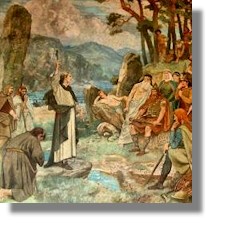
Columba came to Scotland in 563, but he probably went first to the unidentified island of Hinba and may not have settled on Iona until the early 570s. He made one expedition, and perhaps more, up the Great Glen to the court of Bridei, King of the northern Picts. But none of Columba's hagiographers claimed that he converted Bridei or significant numbers of his people. This was not a mission to preach the gospel but an expedition to impress a pagan king, by tribute and magic. The first account of Columba, the Armra, a vernacular poem written probably within a few years of his death in 597, recounted how a serpent had killed a man who had tried to avoid listening to the word of God; when Columba 'made the sign of the cross with his staff over the man's chest, he immediately arose'. By the time of the second account, the Liber de virtutibus sancti Columbae, written by one of Columba's successors as Abbot of Iona sometime in the 660s, the man had acquired a name that of Maelchú, son of Bridei himself.
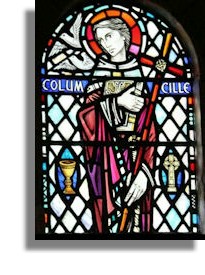
By then Iona had become a missionary church, preaching amongst the northern Picts in the name of the blessed Columba. But in Columba's own lifetime the efforts of Iona were confined largely to the territory of the Cenél Loairn, which must have been at least partly Christianised before he came to it. The first contact of this kinsman of the Irish royal family of Uí Néill after 563 was Conall macComgaill, King of Dalriada. By ordaining Conall's successor, Aedán mac Gabráin, Columba became at once the client and protector of the kings of Dalriada. Far from being an apostle of the Picts, as Bede claimed, Columba was the official apostle of the Dalriadic Scots. Beyond the quite narrow confines of the territory of Cenél Loairn, what may have been more significant than his contacts with the pagan King of Picts was his friendship with the King of the Dumbarton Britons, Rhydderch, who may have been a Christian. The routes to both the north-east and to the south-east were already mapped out in the lifetime of Columba, but these twin missions began only after his death. (The graphic of the stained glass window dedicated to St Columba is in Iona Abbey and is via Wikimedia).


For both Ninian in the fifth century and Wilfrid and Bede in the seventh and eighth-century Northumbrian Church, the terrain of Scotland was the main arbiter of their thinking. They sought to claim as their own the natural breaks of valleys which mostly ran south and north to the barrier of the Forth and to find ways to hurdle that natural frontier. For Columba and his successors as abbots of Iona the geography of Scotland was quite different. Their natural routes of communication were by sea, across to Ireland and along the west coast of the Scottish mainland. The natural barrier for them was the Highland massif, which they called Druim Alban, 'the spine of Britain'. The dove of the church and his followers did not make their first push due east as the crow flies, across the massif before reaching the easier ground of the straths of the Tay and the Earn, but north-east through the huge fault of the Great Glen towards Inverness and south-east towards Lothian and Berwickshire. What is important to realise about that route is that when it was taken, by kings of Dalriada when they became kings of Picts in the ninth century, the Dalriadic church - of Iona - followed, but in a new guise. Columba's relics were split up: some went east to Dunkeld in 849, the rest went to Ireland. Two new paruchiae of Dunkeld and Kells were formed, with Dunkeld as the senior. The cult of Columba went with these kings, but not all of the monks themselves. The shape of the Church which resulted is difficult to pin down precisely: it was not quite a Celtic Church for a Pictish people, nor was it wholly a Roman Church for Pictish kings who had begun to emerge as kings of Scots. It was both of these things and more and therein lay its distinctive strength.





